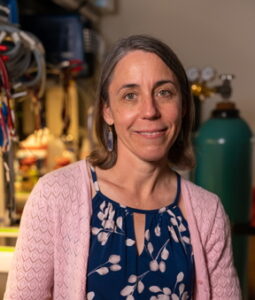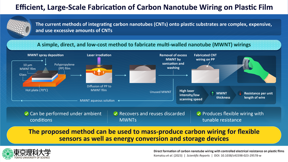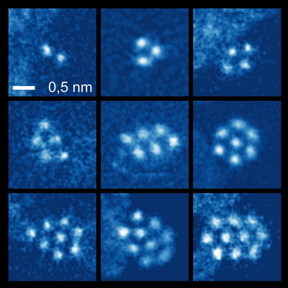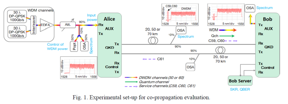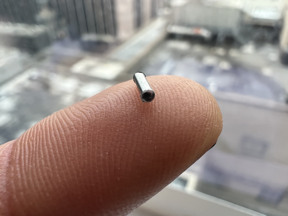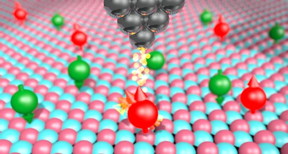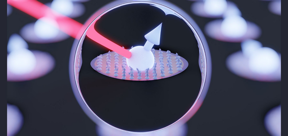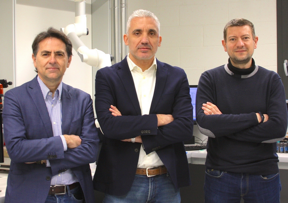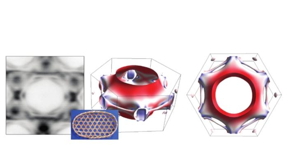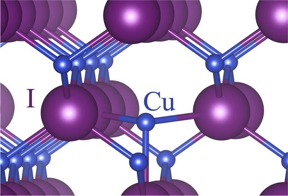Home > Press > Manufacturing advances bring material back in vogue
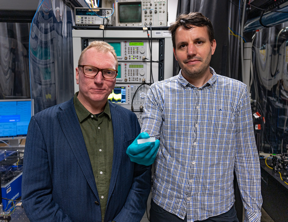 |
| Dr Andy Boes from the University of Adelaide's Institute of Photonics and Advanced Sensing (right) and RMIT University’s Distinguished Professor Arnan Mitchell. CREDIT The University of Adelaide. |
Abstract:
One of the world’s most important artificial materials is back in vogue because scientists are harnessing its properties for new and diverse future applications such as space navigation and farming.
Manufacturing advances bring material back in vogue
Adelaide, South Australia | Posted on January 20th, 2023The University of Adelaide’s Dr Andy Boes and RMIT University’s Distinguished Professor Arnan Mitchell are leaders in developing lithium niobate (LN) to harness its exceptional properties in photonic chips.
“Lithium niobate has new uses in the field of photonics - the science and technology of light - because unlike other materials it can generate and manipulate electro-magnetic (EM) waves across the full spectrum of light, from microwave to UV frequencies,” said Dr Boes.
“Silicon was the material of choice for electronic circuits, but its limitations have become increasingly apparent in photonics. LN has come back into vogue because of its superior capabilities and advances in manufacturing mean that LN is now readily available as thin films on semiconductor wafers.”
A layer of LN about 100 times thinner than a human hair, is placed on a semiconductor wafer/substrate. Photonic circuits are printed into the LN layer which are tailored according to the chip’s intended use. A hundred different circuits may be contained inside a chip the size of a fingernail.
“The ability to manufacture integrated photonic chips from LN will have major impact on applications in technology that use every part of the spectrum of light.” said Distinguished Professor Mitchell.
“Photonic chips can now transform industries well beyond optical fibre communications.”
As there is no GPS on the Moon navigation systems in lunar rovers of the future need to use an alternative system, which is where photonic chips come in. By detecting signals in the infrared part of the spectrum a photonic chip with a laser pointed at it can measure movement without needing external signals.
Dr Boes and Distinguished Professor Mitchell brought together a team of world leaders in LN and published their review of LN’s capabilities and its potential future applications in the journal Science.
Closer to home LN technology can be used to detect how ripe fruit is. Gas emitted by ripe fruit is absorbed by light in the mid-infrared part of the spectrum. A drone hovering in an orchard would transmit light to another which would sense the degree to which the light is absorbed and when fruit is ready for harvesting. Such a system has advantages over existing technology by being smaller, easily deployed and potentially giving more information in real time to farmers.
LN was first discovered in 1949 and has been used in photonics since then but only now are these advances being realised.
“We have the technology to manufacture these chips in Australia and we have the industries that will use them,” said Distinguished Professor Mitchell.
“This is not science fiction it’s happening now and competition to harness the potential of LN photonic technology is heating up.”
####
For more information, please click here
Contacts:
Media Contact
Crispin Savage
University of Adelaide
Cell: +61 (0)481 912 465
Expert Contact
Dr Andy Boes
The University of Adelaide
Cell: +61 (0)477 291 833
Copyright © University of Adelaide
If you have a comment, please Contact us.Issuers of news releases, not 7th Wave, Inc. or Nanotechnology Now, are solely responsible for the accuracy of the content.
| Related Links |
| Related News Press |
News and information
![]() Researchers demonstrate co-propagation of quantum and classical signals: Study shows that quantum encryption can be implemented in existing fiber networks January 20th, 2023
Researchers demonstrate co-propagation of quantum and classical signals: Study shows that quantum encryption can be implemented in existing fiber networks January 20th, 2023
![]() Approaching the terahertz regime: Room temperature quantum magnets switch states trillions of times per second January 20th, 2023
Approaching the terahertz regime: Room temperature quantum magnets switch states trillions of times per second January 20th, 2023
![]() Correlated rattling atomic chains reduce thermal conductivity of materials January 20th, 2023
Correlated rattling atomic chains reduce thermal conductivity of materials January 20th, 2023
Possible Futures
![]() Polymer p-doping improves perovskite solar cell stability January 20th, 2023
Polymer p-doping improves perovskite solar cell stability January 20th, 2023
![]() Vertical electrochemical transistor pushes wearable electronics forward: Biomedical sensing is one application of efficient, low-cost transistors January 20th, 2023
Vertical electrochemical transistor pushes wearable electronics forward: Biomedical sensing is one application of efficient, low-cost transistors January 20th, 2023
![]() Approaching the terahertz regime: Room temperature quantum magnets switch states trillions of times per second January 20th, 2023
Approaching the terahertz regime: Room temperature quantum magnets switch states trillions of times per second January 20th, 2023
Chip Technology
![]() Vertical electrochemical transistor pushes wearable electronics forward: Biomedical sensing is one application of efficient, low-cost transistors January 20th, 2023
Vertical electrochemical transistor pushes wearable electronics forward: Biomedical sensing is one application of efficient, low-cost transistors January 20th, 2023
![]() Approaching the terahertz regime: Room temperature quantum magnets switch states trillions of times per second January 20th, 2023
Approaching the terahertz regime: Room temperature quantum magnets switch states trillions of times per second January 20th, 2023
Optical computing/Photonic computing
![]() New X-ray imaging technique to study the transient phases of quantum materials December 29th, 2022
New X-ray imaging technique to study the transient phases of quantum materials December 29th, 2022
![]() Experimental nanosheet material marks a step toward the next generation of low-power, high-performance electronics December 9th, 2022
Experimental nanosheet material marks a step toward the next generation of low-power, high-performance electronics December 9th, 2022
![]() An on-chip time-lens generates ultrafast pulses: New device opens the doors to applications in communication, quantum computing, astronomy November 18th, 2022
An on-chip time-lens generates ultrafast pulses: New device opens the doors to applications in communication, quantum computing, astronomy November 18th, 2022
![]() Researchers at Purdue unlock light-matter interactions on sub-nanometer scales, leading to ‘picophotonics’ November 18th, 2022
Researchers at Purdue unlock light-matter interactions on sub-nanometer scales, leading to ‘picophotonics’ November 18th, 2022
Discoveries
![]() Polymer p-doping improves perovskite solar cell stability January 20th, 2023
Polymer p-doping improves perovskite solar cell stability January 20th, 2023
![]() Approaching the terahertz regime: Room temperature quantum magnets switch states trillions of times per second January 20th, 2023
Approaching the terahertz regime: Room temperature quantum magnets switch states trillions of times per second January 20th, 2023
![]() Correlated rattling atomic chains reduce thermal conductivity of materials January 20th, 2023
Correlated rattling atomic chains reduce thermal conductivity of materials January 20th, 2023
Announcements
![]() Researchers demonstrate co-propagation of quantum and classical signals: Study shows that quantum encryption can be implemented in existing fiber networks January 20th, 2023
Researchers demonstrate co-propagation of quantum and classical signals: Study shows that quantum encryption can be implemented in existing fiber networks January 20th, 2023
Interviews/Book Reviews/Essays/Reports/Podcasts/Journals/White papers/Posters
![]() Researchers demonstrate co-propagation of quantum and classical signals: Study shows that quantum encryption can be implemented in existing fiber networks January 20th, 2023
Researchers demonstrate co-propagation of quantum and classical signals: Study shows that quantum encryption can be implemented in existing fiber networks January 20th, 2023
![]() Approaching the terahertz regime: Room temperature quantum magnets switch states trillions of times per second January 20th, 2023
Approaching the terahertz regime: Room temperature quantum magnets switch states trillions of times per second January 20th, 2023
![]() Correlated rattling atomic chains reduce thermal conductivity of materials January 20th, 2023
Correlated rattling atomic chains reduce thermal conductivity of materials January 20th, 2023
Food/Agriculture/Supplements
![]() Scientists offer solutions for risky tap water June 17th, 2022
Scientists offer solutions for risky tap water June 17th, 2022
![]() Polymer fibers with graphene nanotubes make it possible to heat hard-to-reach, complex-shaped items February 11th, 2022
Polymer fibers with graphene nanotubes make it possible to heat hard-to-reach, complex-shaped items February 11th, 2022
![]() Unprecedented view of a single catalyst nanoparticle at work: X-rays reveal compositional changes on active surface under reaction conditions October 1st, 2021
Unprecedented view of a single catalyst nanoparticle at work: X-rays reveal compositional changes on active surface under reaction conditions October 1st, 2021
Aerospace/Space
![]() The National Space Society Congratulates NASA on the Success of Artemis I Same-day Launch of the Hakuto-R Lunar Landing Mission will Help Support Future Lunar Crews December 12th, 2022
The National Space Society Congratulates NASA on the Success of Artemis I Same-day Launch of the Hakuto-R Lunar Landing Mission will Help Support Future Lunar Crews December 12th, 2022
![]() Surface microstructures of lunar soil returned by Chang’e-5 mission reveal an intermediate stage in space weathering process September 30th, 2022
Surface microstructures of lunar soil returned by Chang’e-5 mission reveal an intermediate stage in space weathering process September 30th, 2022
![]() Strain-sensing smart skin ready to deploy: Nanotube-embedded coating detects threats from wear and tear in large structures July 15th, 2022
Strain-sensing smart skin ready to deploy: Nanotube-embedded coating detects threats from wear and tear in large structures July 15th, 2022
Photonics/Optics/Lasers
![]() Researchers demonstrate co-propagation of quantum and classical signals: Study shows that quantum encryption can be implemented in existing fiber networks January 20th, 2023
Researchers demonstrate co-propagation of quantum and classical signals: Study shows that quantum encryption can be implemented in existing fiber networks January 20th, 2023
![]() Experimental nanosheet material marks a step toward the next generation of low-power, high-performance electronics December 9th, 2022
Experimental nanosheet material marks a step toward the next generation of low-power, high-performance electronics December 9th, 2022
![]() An on-chip time-lens generates ultrafast pulses: New device opens the doors to applications in communication, quantum computing, astronomy November 18th, 2022
An on-chip time-lens generates ultrafast pulses: New device opens the doors to applications in communication, quantum computing, astronomy November 18th, 2022
![]() Researchers at Purdue unlock light-matter interactions on sub-nanometer scales, leading to ‘picophotonics’ November 18th, 2022
Researchers at Purdue unlock light-matter interactions on sub-nanometer scales, leading to ‘picophotonics’ November 18th, 2022
- SEO Powered Content & PR Distribution. Get Amplified Today.
- Platoblockchain. Web3 Metaverse Intelligence. Knowledge Amplified. Access Here.
- Source: http://www.nanotech-now.com/news.cgi?story_id=57284
- 10
- 100
- 1949
- 3d
- a
- ability
- About
- According
- accuracy
- across
- active
- advanced
- advances
- advantages
- against
- alternative
- Alzheimer’s
- and
- Another
- apparent
- Application
- applications
- architecture
- Artemis
- artificial
- asian
- Australia
- available
- back
- barrier
- because
- become
- being
- Beyond
- biomedical
- bring
- brought
- capabilities
- carbon
- Catalyst
- Center
- CGI
- chains
- Changes
- chip
- Chips
- choice
- COM
- come
- comment
- Communication
- Communications
- competition
- computing
- conducting
- conductivity
- Connect
- content
- could
- create
- credit
- CRISPR
- crucial
- Crystal
- December
- Degree
- deliver
- demonstrate
- demonstrated
- deploy
- deployed
- develop
- developing
- develops
- device
- Devices
- different
- discovered
- Disease
- disorders
- Distinguished
- diverse
- doors
- drone
- easily
- efficient
- Electronic
- Electronics
- emission
- encryption
- Ether (ETH)
- Every
- exceptional
- existing
- external
- farmers
- farming
- feat
- fibers
- Fiction
- field
- films
- Find
- First
- Forward
- found
- from
- full
- full spectrum
- future
- GAS
- generate
- generates
- generation
- gif
- Giving
- gps
- Graphene
- Hair
- Harnessing
- Harvesting
- help
- high-performance
- highly
- Home
- How
- HTTPS
- human
- Imaging
- Impact
- implemented
- important
- improves
- in
- Inc.
- increasingly
- industries
- infection
- information
- Institute
- integrated
- interactions
- Intermediate
- IT
- January
- Japan
- journal
- July
- landing
- large
- large-scale
- laser
- launch
- layer
- leaders
- leading
- light
- limitations
- links
- lithium
- ln
- Lunar
- Magnets
- major
- make
- manufacturing
- material
- materials
- Matrix
- measure
- mice
- Mission
- molecular
- molecule
- Moon
- more
- most
- move
- movement
- nanotechnology
- Nasa
- National
- Navigation
- Need
- needing
- net
- Neutral
- New
- news
- next
- November
- october
- offer
- Offers
- ONE
- opens
- organic
- Other
- part
- participation
- path
- PHP
- plants
- plato
- Plato Data Intelligence
- PlatoData
- please
- possible
- Post
- posted
- potential
- potentially
- Professor
- properties
- published
- Quantum
- quantum computing
- reaction
- ready
- real
- real-time
- reduce
- regime
- Releases
- researchers
- Resistance
- responsible
- return
- reveal
- review
- Risky
- Room
- Rust
- Said
- Save
- scales
- Science
- Science and Technology
- Science Fiction
- scientists
- Search
- semiconductor
- sense
- September
- Share
- Shows
- signals
- since
- single
- Size
- Skin
- smaller
- smart
- Society
- solar
- Solutions
- South
- Space
- Spectrum
- Stage
- start
- States
- Step
- Study
- submit
- success
- such
- superior
- support
- Surface
- Switch
- system
- Systems
- tailored
- Tap
- team
- Technology
- test
- Testing
- The
- The Future
- their
- therapy
- thermal
- threats
- Through
- time
- times
- to
- together
- toward
- Transform
- transmit
- trillions
- under
- unique
- university
- unlock
- unprecedented
- us
- use
- View
- Water
- Wave
- waves
- wearable
- which
- will
- wind
- without
- Work
- world
- world’s
- would
- x-ray
- Yahoo
- zephyrnet










